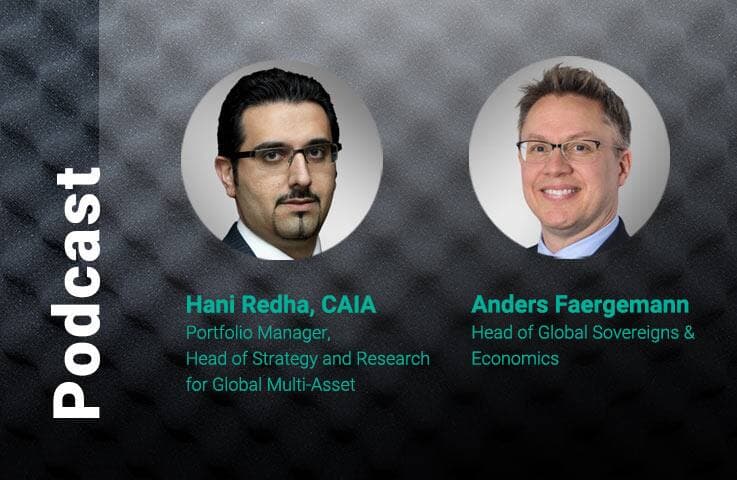Capital Market Line: A Cycle Moving at Warp Speed

Michael J. Kelly, CFA
Global Head of Multi-Asset

Hani Redha, CAIA
Portfolio Manager, Head of Strategy and Research for Global Multi-Asset

Steven Lin, CFA
Portfolio Manager, Global Multi-Asset

Peter Hu, CFA, FRM
Portfolio Manager, Global Multi-Asset

Sunny Ng, CFA
Portfolio Manager, Global Multi-Asset

Mikhail Johaadien
Research Analyst, Global Multi-Asset

The global economy remains in a state of flux amid a surge in inflation caused by demand related to stimulus (both quantitative easing and fiscal supports) and supply-side constraints. Demand-side policies did help at first to avert the unknown during pandemic-related shutdowns of major economies, but ultimately also spurred a precipitous rise in inflation that has surprised policymakers and investors alike. As the dust settles, a new landscape is coming into view, and it is materially different from the previous regime.
The pre-Covid regime, which we termed “Stall Speed,” was characterized by multiple drags on growth and inflation that required extraordinary monetary policy to offset. This, in turn, led to severe market distortions, with real and some nominal interest rates going into negative territory. The new “Warp Speed” regime involves a rapid unwinding of many distortions, driven by a “lack of ‘lacks’” in four key areas:
Lack of deleveraging. Unlike in the post-financial crisis regime, households are not mired in debt, so there’s no need to deleverage. This lack of deleveraging will effectively act as a boost to growth/inflation.
Lack of austerity. We do not expect a return to post-financial crisis fiscal austerity, even in regions such as the eurozone. This lack of austerity will raise the public sector’s contribution to growth from a small negative to a small and ongoing positive, which is a big deal. Decarbonization and higher defense spending are clear sources of incremental growth.
Lack of labor market slack. Labor markets are already tight, with baby boomers retiring and pandemic policy responses enabling a record-fast decline in unemployment. This lack of slack will raise the baseline level of inflation and enable central banks to withdraw their extraordinarily accommodative policies.
Lack of underinvestment. After a decade of slow consumption while consumers fixed their balance sheets, with businesses therefore also slow on the investment side, companies now face tight supply chains and capacity limits, propelling the fastest recovery in capex seen in several decades. Over time this will enhance productivity as wage pressures bite and necessitate spending to boost productivity. Meanwhile, the restructuring of global supply chains to engineer more resiliency is for real.
While these drags were in effect, financial assets (“Wall Street”) outperformed the real economy (“Main Street”). Unfortunately, the policies during that period were much more effective in making capitalization rates generous than in stimulating real economic growth. The current cycle appears to be reversing these outcomes. Recession for markets? Yes. For the economy? Probably not, although we’re heading for a growth scare to be sure.
An enduring theme of ours is the restructuring of supply chains toward “regionalization.” This trend encompasses technological solutions that reduce labor content and enable firms to bring back certain production capabilities to developed markets (DM). The longstanding relationship between wage growth and productivity (with wage spurts preceding productivity gains by eight to 18 quarters) will add fuel to the urgency to revamp supply chains; firms are now motivated to invest to make their businesses more resilient and productive in the face of multiple disruption risks as well as cost pressures. Covid also introduced new attitudes toward work/life balance, with effects that are not yet broadly understood, but likely to have a material impact on the cycle ahead.
China encountered a slowdown prior to its Covid waves during the last few months. This is likely owing to the sharp tightening of regulatory policy on multiple fronts in 2021. With the sort of pragmatism Chinese policymakers used to be known for, they are now reversing course and enacting regulatory, fiscal, and monetary stimulus. The breadth and scale of these U-turns poses a stark contrast to the tightening of policy everywhere else in the global economy. We expect China to continue going its own way in the years ahead, with a less market-driven economy and an accompanying structural deceleration of growth. This might become more evident after the Party Congress later this year, when Xi Jinping is likely to be elected “leader for life,” which we expect to bring on a renewed focus on “common prosperity.” Increasing constraints on the private sector have been a major factor in slowing growth, posing a challenge to many markets that have become reliant on Chinese demand.
Overall, this is a cycle moving at warp speed. China is not the only economy where the government is playing a more decisive role. We expect this less market-driven theme to feature less-efficient growth resulting in shorter cycles with more frequent “resets.” Ironically, this will result in higher macro volatility, with more opportunities to be selective about the level of risk one takes. Deglobalization through renewed regionalization offers less synchronized economies, and greater potential to seek more alpha from being selective and opportunistic about beta. The days of globalization-inspired faster growth while disinflating, with relentlessly rising tides lifting most boats over long, uninterrupted cycles, are unlikely to return anytime soon. At least in real terms. In nominal terms, 3% inflation is the new 2%, and nominal growth may even be a tad higher than before, with a lack of lacks. Meanwhile, the overdose of liquidity that central banks injected into the “Stall Speed” economy (with little or no effect on the real economy but a massive tailwind to financial markets) is also likely to unwind over time.
Our Capital Market Line has steepened and shifted upward as both equities and bonds have sold off. Yet despite these selloffs, the starting point reflected true policy excess, with resulting valuations now merely a bit above average. After the growth scare, equities should benefit from higher nominal cash flows over the next five years, yet with tighter financial conditions and less-favorable capitalization rates. After a long period of underinvestment, commodities now enjoy a structural tailwind, although recent price levels fully reflect this. Fixed income has repriced and now may even benefit somewhat as the slowdown proceeds. Yet the slow erosion of the global savings rate and endurance of quantitative tightening still threaten a slowly evolving fair value in an unfavorable direction.
Capital Market Line as of 30 June 2022 (Local Currency)

Capital Market Line as of 30 June 2022 (USD View, Unhedged)

Please see Capital Market Line Endnotes. Note that the CML’s shape and positioning were determined based on the larger categories and do not reflect the subset categories of select asset classes, which are shown relative to other asset classes only.
Insights From Today’s CML
A steeper Capital Market Line (CML) is shifting to more reasonable expected returns. The slope of our CML has been improving and has also been parallel-shifting upward as both equities and bonds sold off sharply. This signals better (albeit not great) reward for risk-taking. Equities remain the most attractive asset class, while credit spreads have also reset to increasingly attractive levels. Safety asset yields have also improved, yet they remain significantly below inflation levels; the correlation benefit of risk-free bonds with risk assets is likely to remain less than that witnessed in the previous regime.
Neutral on DM government bonds. The starting yields for DM nominal bonds are no longer terrible, and from these levels are likely to come close to maintaining (but not growing) purchasing power. The fundamental insights from our CML process point to higher levels of inflation (versus the last cycle, but lower than present levels) as a result of the shift toward a “Balanced Growth” regime; a clear headwind for fixed-rate safety assets. Yet the reset in bond prices has now absorbed much of the intermediate-term drag from tightening financial conditions. DM nominal bonds have an improved ability to provide some downside protection once again due to their yield resets. We see more opportunities for a dynamic approach to managing duration in shorter, more frequent cycles ahead.
Equities: a shift in the source of total return toward cash flow growth. The previous regime resulted in exceptional total returns for equities, propelled by earnings growth that was never as poor as the depressed expectations presumed, along with multiple expansion from an upward-trending global savings rate teamed with “QE forever”-oriented policies. The policy mix of the next cycle will support higher nominal cash flows as nominal GDP growth improves, offset by multiple contractions. Equity risk premiums (ERPs) remain elevated and are likely to stabilize or improve (which is typical when interest rates trend up) rather than continue to rise, providing a partial offset to higher bond yields. Outperformance will be driven more by companies’ ability to generate higher growth with lower variability, higher and steadier enough to outrun a creeping drag from valuations. Our ongoing lukewarm outlook for emerging market (EM) growth, dragged down by China and deglobalization trends, leaves EM equities looking relatively unattractive. With increased investment, alongside higher military and climate spending, commodity producers within EM may be an exception; however, ESG considerations mean that a highly selective approach is needed to access those EM opportunities where improvement is likely.
Continue seeking uncorrelated, idiosyncratic market opportunities. Given the headwinds to core equity and bond markets from gradually tightening financial conditions (after the deluge), we have focused our resources on identifying relatively uncorrelated, idiosyncratic opportunities that received less of a tailwind from the last 40 years of declining real interest rates. One example is European carbon credits, which have a policy-driven structural tailwind, as climate change remains a priority for global governments. Another is commodity carry, which currently benefits from a favorable curve structure and high-single-digit roll yield, with the potential to release value upon adverse demand shocks. We recommend investors diversify into relatively uncorrelated opportunities until monetary headwinds have been absorbed, a process that could take many years.
Commodities are challenged by a cyclical headwind but benefit from structural tailwinds. The developments over the last quarter have added to incremental demand for commodities in the years ahead, via higher military and decarbonization spending. Reshoring of production facilities will also add incremental demand for various commodities. This new spending could offset slowing demand growth from China, the single largest consumer of commodities. The lack of supply growth provides a “floor” for certain commodities, yet we find that much of this incremental demand has already been reflected in the sharp rise in commodity prices. The current global “growth scare” is a cyclical headwind for commodity prices, but given these structural headwinds, attractive entry prices may emerge.
The Fundamentals Driving Our CML
Transition from overheating toward a “Balanced Growth” regime. The current overheating in the global economy should transition (either gracefully or not) to a more balanced growth profile over the coming quarters. The new regime should be distinctly different from the “Stall Speed” regime in the decade prior to the pandemic. Growth and inflation should no longer have downside risks to central bank targets, eliminating the need for extraordinary policy support. Core drivers of this change relative to the previous regime include the lack of deleveraging by the private sector, the lack of austerity by the public sector, and multiple channels of investment activity after a decade of underinvestment (see below).
Shorter and more volatile cycles. Unlike in the decade after the global financial crisis, the policy response to the pandemic has left the global economy without a large negative output gap; labor markets are already tight, just two years into the recovery. This lack of slack means that the economy will be more susceptible to overheating and require restrictive policy settings compared to the “Stall Speed” regime, where policy was perpetually dealing with demand deficiencies, with attempts to offset these with monetary largesse. The result may be shorter cycles and more frequent, perhaps shallow, recessions to reset macro conditions. The market narrative continues to expect a return to Stall Speed (for the economy, but back-to-the-races for markets); yet in our view, the previous cycle, where markets massively outperformed economies, will come to be seen as an outlier. Prepare for the flip side, with less-fragile economies teamed with more sluggish markets.
More balanced fiscal and monetary policy. Rather than relying exclusively on monetary policy while fiscal policy acted as a drag on growth, balanced growth/inflation conditions imply more balanced policy settings relative to the previous regime. Tighter output gaps should be supportive of inflation, and give central banks the space to gradually drain today’s massive excess liquidity. On the fiscal front, the pandemic revealed the effectiveness of fiscal policy in dealing with crises, and the lack of sovereign debt sustainability issues has revealed the scale of policy space to manage through crises without the need to snap back to austerity. The current inflationary problems may result in a better calibration of the scale of policy response, leading to better outcomes overall.
Maturation of the drive to decarbonize. Recent spikes in energy prices give a glimpse of the difficulty in assessing and managing the knock-on effects of decarbonization policies. The urgency to tackle climate change and achieve Net Zero is not waning. Yet there is a growing recognition that this transition must proceed at a realistic pace, dictated by the requisite investment in renewable assets along with redundancy systems to prevent disruption. We expect “two steps forward, one step back” over the years ahead: Two steps forward in the sense that the investment plans will be accelerated, but one step back due to the need to rely on fossil fuels for longer than initially envisaged given the volatility of renewable energy sources. Commodity prices may prove to be an important de facto determinant of the “speed limit” of these initiatives.
Reshoring and the restructuring of supply chains. Companies have been bombarded by shocks to their supply chains over recent years, including the US-China trade war in 2018, the global pandemic in 2020, and the Russia-Ukraine war in 2022. These shocks have cemented the need for companies to restructure their supply chains to avoid costly disruption by diversifying their production bases and moving closer to end-demand markets. Companies now appear willing to pay a premium to secure supplies in a less globalized world. This will require substantial investment and will leave the system less efficient than in the last few cycles. Regionalization will be less supportive of EM economies overall, and decisions will be more forcefully influenced by political alignment. This theme is gaining traction across multiple sectors.
China walks the tightrope of growth and geopolitical alignment. 2022 has been an extremely challenging year for China as a result of its renewed battle with Covid, managing fallout from 2021’s regulatory crackdowns, and attempts to manage its diplomatic relationships in the wake of Russia’s invasion of Ukraine. And the year is far from over; 2022 is also important politically for the country’s leadership, with the 20th Party Congress, which will likely cement the pivot toward “common prosperity” and a strategic focus on sustainable and inclusive growth. To date this has disincentivized China’s private sector, leading to slower growth. Policymakers will fine-tune fiscal, regulatory, and monetary policies to avoid disruption and slow the slowdown, yet the impact on growth is likely to be felt globally through lower import growth. The transition could involve upheaval and volatility. China’s political decisions on the global stage will also be key. We expect China to avoid outright confrontations but be increasingly assertive in charting its path forward.
Capital Market Line Endnotes
The Capital Market Line (CML) is based on PineBridge Investments’ estimates of forward-looking five-year returns and standard deviation. It is not intended to represent the return prospects of any PineBridge products, only the attractiveness of asset class indexes, compared across the capital markets. The CML quantifies several key fundamental judgments made by the Global Multi-Asset Team for each asset class, which, when combined with current pricing, results in our annualized return forecasts for each class over the next five years. The expected return for each asset class, together with our view of the risk for each asset class as defined by volatility, forms our CML. Certain statements contained herein may constitute “projections,” “forecasts,” and other “forward-looking statements” which do not reflect actual results and are based primarily upon applying a set of assumptions to certain financial information. Any opinions, projections, forecasts, and forward-looking statements presented herein are valid only as of the date of this document and are subject to change. There can be no assurance that the expected returns will be achieved over any particular time horizon. Any views represent the opinion of the investment manager and are subject to change. For illustrative purposes only. We are not soliciting or recommending any action based on this material.
About the Capital Market Line
The Capital Market Line (CML) is a tool developed and maintained by the Global Multi-Asset Team. It has served as the team’s key decision support tool in the management of our multi-asset products. In recent years, it has also been introduced to provide a common language for discussion across asset classes as part of our Investment Strategy Insights meeting. It is not intended to represent the return prospects of any PineBridge products, only the attractiveness of asset class indexes compared across the capital markets.
The CML quantifies several key fundamental judgments made by the Global Multi-Asset Team after dialogue with the specialists across the asset classes. We believe that top-down judgments regarding the fundamentals will be the largest determinants of returns over time driving the CML construction. While top-down judgments are the responsibility of the Multi-Asset Team, these judgments are influenced by the interactions and debates with our bottom-up asset class specialists, thus benefiting from PineBridge’s multi-asset class, multi-geographic platform. The models themselves are intentionally simple to focus attention and facilitate a transparent and inclusive debate on the key drivers for each asset class. These discussions result in 19 interviews focused on determining five year forecasts for over 100 fundamental metrics. When modelled and combined with current pricing, this results in our annualized expected return forecast for each asset class over the next five years. The expected return for each asset class, together with our view of forward-looking risk for each asset class as defined by volatility, forms our CML.
The slope of the CML indicates the risk/return profile of the capital markets based on how the five-year view is currently priced. In most instances, the CML slopes upward and to the right, indicating a positive expected relationship between return and risk. However, our CML has, at times, become inverted (as it did in 2007), sloping downward from the upper left to the lower right, indicating risk-seeking capital markets that were not adequately compensating investors for risk. We believe that the asset classes that lie near the line are close to fair value. Asset classes well above the line are deemed attractive (over an intermediate-term perspective) and those well below the line are deemed unattractive.
We have been utilizing this approach for over a decade and have learned that, if our judgments are reasonably accurate, asset classes will converge most of the way toward fair value in much sooner than five years. Usually, most of this convergence happens over one to three years. This matches up well with our preferred intermediate-term perspective in making multi-asset decisions.
Disclosure
Investing involves risk, including possible loss of principal. The information presented herein is for illustrative purposes only and should not be considered reflective of any particular security, strategy, or investment product. It represents a general assessment of the markets at a specific time and is not a guarantee of future performance results or market movement. This material does not constitute investment, financial, legal, tax, or other advice; investment research or a product of any research department; an offer to sell, or the solicitation of an offer to purchase any security or interest in a fund; or a recommendation for any investment product or strategy. PineBridge Investments is not soliciting or recommending any action based on information in this document. Any opinions, projections, or forward-looking statements expressed herein are solely those of the author, may differ from the views or opinions expressed by other areas of PineBridge Investments, and are only for general informational purposes as of the date indicated. Views may be based on third-party data that has not been independently verified. PineBridge Investments does not approve of or endorse any republication of this material. You are solely responsible for deciding whether any investment product or strategy is appropriate for you based upon your investment goals, financial situation and tolerance for risk.



